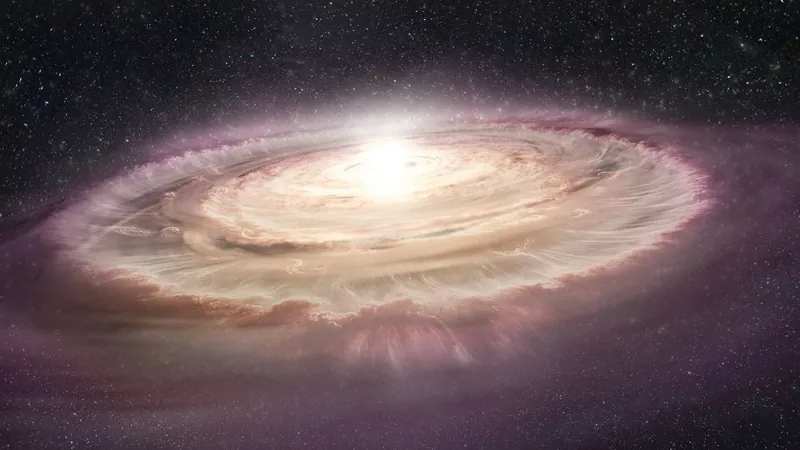
Shocking Discovery: Planets Can Form in the Most Extreme Conditions!
2025-01-12
Author: Rajesh
Introduction
In a groundbreaking revelation for the field of astrophysics, recent research has upended long-held beliefs about planet formation. Traditionally, the Nebular Hypothesis has guided our understanding of how stars and their planetary systems develop from vast clouds of dust and gas—known as nebulae—that undergo gravitational collapse. This process typically leads to the formation of a protoplanetary disk, from which planets gradually accrete over time. What scientists have discovered recently, however, is that this cosmic phenomenon can occur even in the most inhospitable environments.
Key Findings
Using the world-renowned Atacama Large Millimeter/submillimeter Array (ALMA) in Chile, an international team of astronomers captured high-resolution images of eight protoplanetary disks located in the Sigma Orionis cluster, a star grouping within the Orion constellation. The astounding finding? Most of these disks exhibited noticeable gaps and rings—strong indicators that giant planets are potentially forming, even in the presence of intense ultraviolet (UV) radiation from nearby massive stars.
Research Team and Methodology
Led by Jane Huang, an assistant professor at Columbia University, the research team included experts from institutions such as NASA, the Ludwig Maximilian University of Munich, and the University of Hawaii at Manoa. Their study has been recently published in the prestigious journal, *The Astrophysical Journal*, adding a significant chapter to the story of planet formation.
Technical Advances
The team utilized ALMA's most advanced configuration, effectively zooming in on their targets and achieving a resolution of about eight astronomical units—the equivalent of eight times the distance between the Earth and the Sun. They successfully identified gaps and rings in five of the examined disks, showcasing structures similar to those observed in other known planetary systems. The standout among these was the disk SO 1274, which featured five distinct gaps, suggesting a potentially rich collection of planets in the works.
Implications of UV Radiation
What truly sets this research apart is its focus on disks exposed to severe UV radiation, a condition typically believed to hinder planet formation. Previous studies have mainly examined disks in calmer UV environments, leaving a gap in our understanding of how star systems evolve under harsher conditions. As Huang stated, "We expected the high levels of radiation in this cluster to inhibit planet formation in the outer regions of these disks. But instead, we’re seeing signs that planets may be forming at distances of tens of astronomical units from their stars."
Broader Implications
This discovery not only reshapes our perspective on how planets can emerge but also suggests that the mechanisms behind planet formation are remarkably adaptable. It hints that our Solar System could even have formed in a similarly tumultuous environment, laying the groundwork for future astronomical research.
Conclusion
However, the implications are profound—a warning that we must not overlook the potential planets may exist in regions of the galaxy previously deemed too treacherous for formation. The team acknowledges that the observed structures might also result from complex interactions between forming planets and disk material, signaling a need for follow-up studies in even more extreme conditions.
In conclusion, this revolutionary research emphasizes the resilience and versatility of planet formation processes across our galaxy. The universe continues to surprise us, showing that life-sustaining planets could be lurking in the unlikeliest of places! Could your next cosmic neighbor thrive in a hostile environment? Stay tuned as we uncover more secrets of the universe!
 Brasil (PT)
Brasil (PT)
 Canada (EN)
Canada (EN)
 Chile (ES)
Chile (ES)
 Česko (CS)
Česko (CS)
 대한민국 (KO)
대한민국 (KO)
 España (ES)
España (ES)
 France (FR)
France (FR)
 Hong Kong (EN)
Hong Kong (EN)
 Italia (IT)
Italia (IT)
 日本 (JA)
日本 (JA)
 Magyarország (HU)
Magyarország (HU)
 Norge (NO)
Norge (NO)
 Polska (PL)
Polska (PL)
 Schweiz (DE)
Schweiz (DE)
 Singapore (EN)
Singapore (EN)
 Sverige (SV)
Sverige (SV)
 Suomi (FI)
Suomi (FI)
 Türkiye (TR)
Türkiye (TR)
 الإمارات العربية المتحدة (AR)
الإمارات العربية المتحدة (AR)